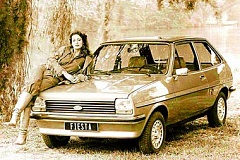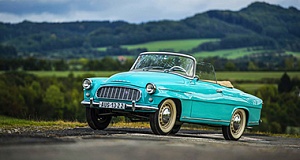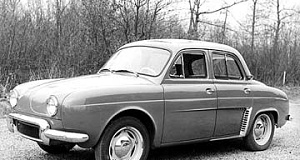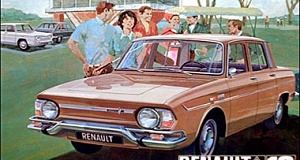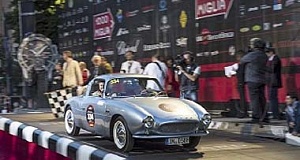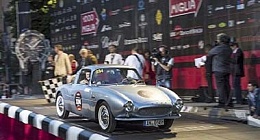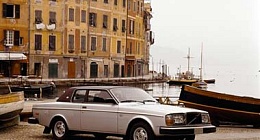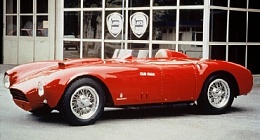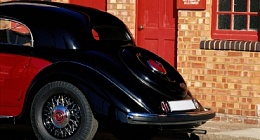A comienzos de los años 50, Mercedes-Benz desarrolló los 300 SL,un automóvil de competición de la serie W194 . Una mezcla única de tres ingredientes: construcción, aerodinámica y ligereza. El SL original fue presentado a la prensa el 12 de marzo de 1952 en la misma autopista que une Stuttgart con Heilbronn.
Palmarés : Segundo lugar y cuartos en la Mille Miglia, triple victoria en el gran premio de Berna, doblete e en las 24 horas de Le Mans, triunfo cuádruplo en el gran premio de Nürburgring y una victoria doble en el 3ª Carrera Panamericana en México.
Unidades fabricadas
300 SL W194 1952 : 10 unidades
300 SL Prototipo W194/11 de 1953: Unidades 1
Datos técnicos
Año: 1952
Chasis: Tubular
des fabricadas: 10
Motor: Seis cilkindros en línea,
Cilindrada: 2.995cc
Potencia: 170cv a 5200rpm
Alimentación: Tres carburadores Solex dobles
Peso aproximado: 1060 kg
Velocidad máxima: 230km/h

Extensive restoration of the oldest existing SL at the Mercedes-Benz Classic Center
·The 300 SL (W 194) is one of the most important racing cars of the 1950s
·Visible traces of a long, exciting vehicle life.
Stuttgart – The roots of the SL-Class lie in motor racing: in the early 1950s, Mercedes-Benz
developed the 300 SL, W 194 series racing car. It was a unique blend of three ingredients:
lightweight construction, aerodynamics and reliability. The original SL was presented to the stunned press on 12 March 1952 on the motorway between Stuttgart and Heilbronn – a surprise coup absolutely in line with the later great sports successes of the W 194.Because the 1952 racing season was exceptionally successful for Mercedes-Benz. These were the results reaped by the 300 SL that year: second and fourth places at the Mille Miglia, a triple victory at the Bern Sports Car Grand Prix, a double win at the 24 Hours of Le Mans, a fourfold triumph at the Great Jubilee Prize at Nürburgring and a double victory in the 3rd Carrera Panamericana in Mexico. The brand returned to motor sports – and through the publicity effect, to the international markets – with a great fanfare. In the Second World War post-era at the beginning of the 1950s, characterised by the reconstruction in Germany, this was a decisively important signal, for great parts of the country still lay in ruins. The production plants and office buildings of the then Daimler-Benz AG were not all fully rebuilt yet, either. However, the incipient “economic miracle”, as the economic revival was to be called, could already be felt. And the Mercedes-Benz 300 SL fitted in perfectly: rising, one could say, like a phoenix from its ashes, it led the way for the brand to return to its erstwhile splendour.

The very looks of the vehicle helped here, for with its slender, elegant matt silver-coloured
bodywork and its large Mercedes star in the radiator grille, it embodied high speed even while standing perfectly still. And then there were its gullwing doors, in the case of the very first W 194 series, very short indeed, resembling entry hatches more than actual doors: they lent the racing car a very characteristic aspect – and were instrumental in creating the SL myth. The vehicle with chassis number 2 had these short gullwing doors, making it the oldest SL, and at the same time the only one in existence anywhere in the world today with this particular feature.

Restoration of the 300 SL with chassis number 2
The first 300 SL, the premiere vehicle from 1952, no longer exists; it was property of the factory and was eventually scrapped. However, the second car built, with chassis number 194 010 00002/52 still exists and has remained in the property of the firm ever since it was built in 1951/52. The “/2” embossed on diverse parts bears witness to their genuine nature. This oldest SL in existence was painstakingly restored for the “60 years of the SL” anniversary to be celebrated in 2012. To do this, the Mercedes-Benz Classic Center in Fellbach examined every single part of the entirely disassembled vehicle and wherever necessary reconditioned the component in line with the highest standards of authenticity and quality. The work was based on one clear principle: to preserve substance and patina in every way; at the same time, as far as possible the vehicle was to look as it did in 1952: thus, the second 300 SL (W 194) ever built shines again in new splendour – while displaying the traces of a long and exciting vehicle life with pride.

In the course of the restoration work, first of all, the space frame, the actual backbone of the vehicle, was measured using the most advanced methods. The result: the dimensional deviations were well within the acceptable tolerance range, even after 60 years. This is where the advantages of Number 2’s individual history become evident. Because although the vehicle was used in racing events in 1952, it was never used as a racing car, only as a training and replacement vehicle, for instance in the Bern Sports Car Grand Prix. And this SL was never involved in an accident, either, which also contributed to its overall very good condition today.

A vehicle with character
The W 194 with chassis number “2” is one of two vehicles built that share a special history: number 1 and number 2 were built by hand in Rudolf Uhlenhaut’s Stuttgart-Untertürkheim racing workshop.

The following eight vehicles, which were used mainly in the racing events of the year 1952, were manufactured more rationally in the Sindelfingen factory, for instance using pressed parts for the chassis – without using large-series production methods, though.
In those days it was usual to build racing cars more or less as individual items, because each one was designed directly with its specific task in mind. And during the car’s assembly, too, the basic design was modified again and again in order to seek the very best results. This made a unique specimen of each W 194 in a sense – the first two having a much stronger aura of handcrafted one-of-a-kind specimens.

This special character of Number 2 is visible in many of its components: for instance the welding seams show clearly that they were made by hand. Or for example the exhaust system, the fuel tank, the windscreen washer fluid reservoir and the seat frames are all recognisably individually crafted.
Its lightweight design was a great asset for the W 194. This can be seen in its aluminium magnesium-sheet metal body, which in this vehicle is very thin. It is also evident in the diverse components that are made lighter by means of perforations, for example the front axle, even the handbrake lever. Every gram is skimped on –and that’s why the expensive material magnesium is used, for instance, on the transmission bell, and the rear axle- and steering gear housings. Other components are consistently made from aluminium, for example the fuel tank, the washer fluid reservoir and the main brake cylinder. And the effort is worthwhile: the ready-to-drive W 194 had an unladen weight of just 1060 kilograms.
The sum total of the effort and sums invested show the W 194 to have been a costly project, i.e. a project with prestige character indeed: the company was prepared to invest at that time in order to regain prestige on the international level through the positive publicity effect of the racing successes. And the plan bears fruit, exactly as expected.

Restoring the bodywork
The restoration of the original bodywork was particularly complex and demanding. It was made from very thin aluminium-magnesium sheet metal and was thus by its very nature delicate. In addition, time has left its marks on it in many places, including the marks of earlier partial restoration efforts. In some places the bodywork was very deformed. The experts now went to work with the objective of returning the vehicle to its original aspect of being all “of one piece”. The experts’ work towards the original restored bodywork took around five months, from May to September 2011.
The overall character was preserved. Irregularities on the body surface as well as a
left-hand-right-hand asymmetry were retained – the original bodywork was hand-made: this is a part of the vehicle history and this is how it is shown again now.

The engine
The W 194’s engine was derived from the power plant of the Mercedes-Benz 300 (W 186) luxury Saloon.
For this reason, the engine block of this SL has the number “186” embossed on it, while the
modified cylinder head, on the other hand, bears the number “194”: for its use as a racing car, the engineers boosted the engine’s output to around 170 bhp (125 kW), employing among other things three Solex sports carburettors and a sports camshaft. The sports engine was equipped with dry-sump lubrication and installed in a position canted 50 degrees towards the left so as to be able to fit under the very flat bonnet.
Within the framework of the restoration work, the original engine was completely overhauled. On a modern-day test rig it demonstrated its endurance – it ran for around 10 hours, confirming as it did, the original output specifications. The reconditioning of the two electric fuel pumps, for which today no replacement parts exist, was complex. However, the specialists from Mercedes-Benz Classic were also able to recreate these true to the originals.
The engine also shows the character of Number 2: for example the air filter housing is visibly made-to-measure by hand – and between the housing and the closed bonnet there is not even enough space for a person’s hand.

The assembly
The chassis of the W 194 was completed in the course of several months at the Mercedes-Benz Classic Center. Every single component was painstakingly cleaned and examined and, if necessary, reconditioned. The mechanics thus often advanced two steps, only to have to go back one – at times an arduous business. But one that in the end was successful, so that the 1952 racing car was recreated piece by piece anew.
One exceedingly fortunate circumstance was that the vehicle was virtually complete. The large Mercedes star on the radiator, for instance, can be seen to be handmade, as evidenced by the small irregularities it displays. It was polished and reattached, as was the original “300 SL” lettering.
The original rear licence plate “W59-4029” still exists, too, while the front number plate was faithfully reproduced. The wooden steering wheel, the gearshift knob, the instruments, the switches: all present and correct. The front axle was reconditioned. It was entirely nickel-plated a method in use in those days to enable potentially safety-relevant hairline cracks to be easily detected on the racetrack. The rear axle showed, in particular through the state of its mechanical components, that Number 2 had not been subjected to excessive strain, since all the gear wheels were in virtually new condition. The original Alfin brake drums were tested, trimmed and reinstalled; the original riveted wheel rims were clad in Dunlop D8 tyres.
The interior of the W 194 breathes the air of those days. The seat covers, made from the
characteristic blue tartan pattern, are new, while the roof lining and the rest of the cover fabric had been preserved in their entirety; they were cleaned and replaced, now gracing the vehicle again. And the aluminium seats under the fabric were also able to be used without excessive work having to be carried out on them. This way the entire interior was recreated – and yet shows the venerable traces of time.
A very special bravura piece was re-creating the body paintwork. The original nitro-lacquer was called “silver bronze”. Today it is no longer available and due to the environmental regulations in force, may no longer be used. Thus, the paint supplier of 1952 now undertook exhaustive research based on contemporary photographic and film material in order to recreate a paint colour as close
as possible to the original, producing a precise formula for a water-based paint. With this matt silver paint the W 194 now shines once again as it once did many years ago.
Number 2 was given new window panes. A plexiglas pane is used for the windscreen. The side windows with their air flaps and the rear window are also made from Plexiglas and were provided by the same supplier who made the plastic glazing for this 300 SL in 1952.
Restoration work on the oldest SL in existence took a total of around nine months. But the effort was worth the while: the car is now radiant in all its erstwhile beauty. When the engine of the Mercedes-Benz 300 SL with its original licence plate “W59-4029” is started and the vehicle gets swiftly under way, one can well believe that it is able to reach a top speed of 230 km/h – and take its place among the most successful racing cars of the 1950s.
Mercedes-Benz 300 SL (W 194 series)
Year built: 1952
Number of units: 10
Engine: six-cylinder in-line engine, overhead camshaft, three Solex double carburettors, dry-sump lubrication
Displacement: 2.995 cc
Output: 170 bhp (125 kW) at 5200 rpm
Kerb weight: approx. 1060 kg
Top speed: 230 km/h
Motor sports as initial fuse: the Mercedes-Benz 300 SL racing sports car, W 194 series (1952-1953)
· The first racing car from Mercedes-Benz after the Second World War
· Combination of series-production technology and innovative lightweight design
· Racing as a coupé and as a roadster
· 1953 racing sports car prototype shows elements of the production sports car
Mercedes-Benz 300 SL was the designation of the competition racing car from Mercedes-Benz with which the brand returned to international motor sports for the first time after the Second World War in 1952. Although this car was not sold to the public, it did light the fuse for the development of the later SL-Class from Mercedes-Benz. The development of the 300 SL began in 1950, when Mercedes-Benz began to think about a return to racing. However, the attempt to reactivate the 1939 W 154 Grand Prix racing car met with failure in Argentina in 1951. So engineers pressed forward the development of the new racing car instead. Some of its components came from the Mercedes-Benz 300 luxury saloon (the so-called “Adenauer Mercedes”).
On 15 June 1951, the Board decided to resume participation in racing events from 1952 on, and gave the final orders for the construction of the “300 Sports Light”, as the new vehicle was designated.

Later on the suffix was abbreviated – giving the combination SL for the model series. Its M194 engine was derived from the M 186 engine of the Mercedes-Benz 300 type luxury saloon and the elegant two-door 300 S, having an inclined separation plane between cylinder-head and engine block, an overhead camshaft, large intake valves, combustion chamber in engine block and pistons, a displacement of 3 litres and an output of 115 bhp (85 kW). For its use in the racing car the engineers increased the engine’s output to around 170 bhp (125 kW). The sports engine differed from the one installed in the saloon and coupé not only in its output, but also in its installation position, slanted 50 degrees to the left, and in having a dry-sump lubrication system, which due to the absence of the oil sump, enabled a lower installation height.
Weight savings were hardly possible with the engine and the transmission of the W 194 that was being created. And this was also true of the heavy steel axles also taken from the 300 model. There thus remained only the frame and the exterior skin for any possible weight-savings. Another possibility for enhancing competitiveness was to create a body as aerodynamic as possible. Rolf Uhlenhaut, at that time Head of passenger car research at Daimler-Benz, took up his idea of a lightweight tubular frame again, an idea he had entertained some years before. The designers then carried the concept forward to its logical conclusion, creating a lightweight, extremely torsionally rigid frame consisting of very thin highly-alloyed steel tubes assembled to form triangles, whose tubular elements were only subjected to tensional and compressive forces. The entire frame weighed just 50 kilograms and became the backbone of the W 194. The frame of the 300 SL (W 198), the production sports car presented in 1954, was also derived from this frame.
The coachbuilders in Untertürkheim and Sindelfingen spared no effort with the vehicle aluminium body. Thanks to the canted position of the engine and the aerodynamic profile they strove to create, the car was very low, free of trim right down to the underbody, with an elegant low bonnet line, intuitively round-shaped, with recessed headlamps and wheels entirely covered by the bodywork. The classic Mercedes-Benz radiator shape was replaced by a flat racing car front end analogous to that of pre-war cars. The Mercedes star dominated the radiator grille prominently. The passenger compartment was made as narrow as possible, with a strongly raked windscreen, curving round towards the A-pillars. The large rear window flowed over into the aerodynamic rear end. The result was a relatively small frontal area: 1.8 square metres. A drag coefficient was measured on a 1-in-5 scale model and found to be cd = 0.25, a very good value indeed for those days, and that, even without considering the realistic airflow through the engine compartment.
The doors are a chapter all of their own: in order to bestow on a space frame the desired
highest-level rigidity, it has to be as wide as possible in the passenger cell sector. This
requirement led to the spectacular and later so famous gullwing doors. These doors, deeply incut into the roof, opened upwards and reached only down to the waistline, resembling hatches more than doors. In order to facilitate access over the high side sill, the bodywork designers had even originally intended to have an access step in the lower part of the vehicle body flank; however, this feature was never realized. At the time, the FIA regulations did not specify the type and direction of opening doors. In spite of this, the stewards got very flustered when the vehicle was presented to them for scrutineering before the Mille Miglia in May 1952. In the run-up to the 24 Hours of Le Mans the doors were extended down into the car’s flanks – to forestall any future protests – thereby assuming their final shape. Now they looked even more like outspread wings, for which reason the car was dubbed “gullwing” by the North Americans and “papillon” (butterfly) by the French. In two races, by the way, the 300 SL participated not in the guise of the “gullwing” car, but with a roadster body.
The interior was fully padded and lined, radiating a level of comfort unusual for racing cars.
Speedometer and rev counter were located in the optimum position in the driver’s field of vision, below them and in somewhat smaller format were the gauges for water temperature, fuel pressure, oil temperature, and oil pressure. Even a stopwatch was installed. The bucket-type seats with high side sections were covered with tartan-style woollen fabric; the four-spoke steering wheel was removable to facilitate climbing in.
The archetype of the 300 SL, chassis number W 194 010 00001/52, completed its first test drives in November 1951, on the Solitude racetrack on the outskirts of Stuttgart, on the Nürburgring and on the Hockenheimring. The Mercedes-Benz 300 SL racing sport coupé, unusually smooth and, at a height of just 1,225 millimetres, exceptionally low, was presented to the excited and stunned press on the motorway between Stuttgart and Heilbronn on March 12, 1952.
A total of ten W 194 series cars were built for the 1952 season. After the Le Mans race, it was planned to enter the SL in a sports car race on the Nürburgring. In order to make the cars intended for this race as light as possible, they were given a roadster body; a further, narrower car had been set up as a roadster right from the start. To permit the driver easy access, the section of the door extending into the side of the car was retained, and a small windscreen was mounted to deflect air and flying insects. This resulted in a weight advantage of 100 kilograms over the coupé.
The year 1952 was an extremely successful one for the Mercedes-Benz racing department: the results of that year for the 300 SL: second and fourth places in the Mille Miglia; triple victory in the Sports Car Grand Prix of Bern; double victory at the 24 Hours of Le Mans; quadruple victory in the sports car race on the Nürburgring. The last big adventure of the season was participation in the third Carrera Panamericana Mexico, an arduous long-distance race over five days and eight stages, 3,100 kilometres across Mexico. Mercedes-Benz accepted the challenge and entered two coupés and two roadsters in this rally, all powered by engines with an output that had meanwhile been boosted to 180 hp (132 kW). Karl Kling with Hans Klenk and Hermann Lang with Erwin Grupp scored a legendary
double victory for Mercedes-Benz in November 1952 in this contest.
The 300 SL was reengineered for the 1953 season. The eleventh SL manufactured received the number W 194/11. Its bodywork was now entirely made from magnesium sheet, even lighter than aluminium. In the wind tunnel it gained – especially in its front section – not only a new face, but also a better airflow through the engine compartment thanks to an optimised shape. The engine output rose, too, among other things thanks to petrol direct injection, which boosted the power of the six-cylinder unit to 215 bhp (158 kW). The rear axle was further developed to a low-pivot single-joint swing axle, while the transmission was flanged on the rear axle following the transaxle principle, which made for a more balanced weight distribution. The wheelbase was shortened by 100 millimetres. The vehicle stood firmly on 16-inch wheels, and the use of disc brakes was considered.
This further-developed 300 SL – in-house affectionately called “carpenter’s plane” on account of its front end – did not actually get to race. However, its bodywork with its angular radiator, compact dimensions and ventilation fins as well as its engine with direct petrol injection already showed the genes that were to make the 300 SL production sports car of 1954 so unique. This production sports car was to become the dream sports car of the 1950s and in 1999 was voted “Sports Car of the Century”.
Production figures for Mercedes-Benz 300 SL (W 194)
Model Internal designation Production period: pre-production to end Number of units
300 SL W 194 1952 10
300 SL prototype W 194/11 1953 1

